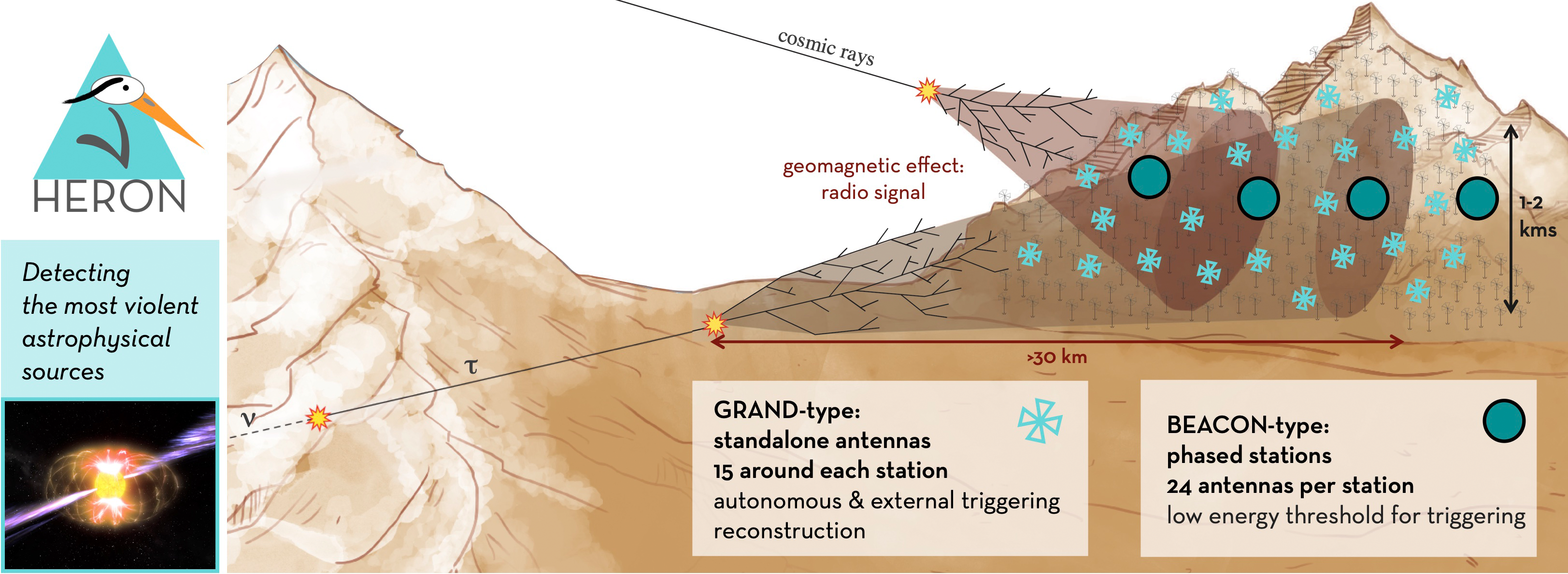THE HERON PROJECT SELECTED FOR AN ERC SYNERGY GRANT 2025
HERON (Hybrid Elevated Radio Observatory for Neutrinos) is a hybrid, elevated radio observatory project for the detection of ultra-high-energy neutrinos, to be installed in Argentina[1]. The project is led by four principal investigators (PIs): Jaime Alvarez Muñiz (University of Santiago de Compostela, Spain), Kumiko Kotera (IAP, CNRS, France), Olivier Martineau (LPNHE, Sorbonne University, France), and Stephanie Wissel (Penn State University, USA), with an Argentinian partner, Federico Sanchez (CNEA, Argentina). Over six years, the observatory will track neutrino bursts associated with cosmic ray sources (gamma-ray bursts, etc.), revealing the mechanisms behind the most violent astrophysical phenomena at unprecedented energies.
HERON combines the strengths of two complementary approaches: that of GRAND[2], based on a large array of autonomous radio antennas, and that of BEACON[3], which uses interferometric detection with a phased array of closely spaced antennas. By merging these two techniques, the instrument will benefit both from the enhanced sensitivity of phased arrays and from the excellent reconstruction capability and background rejection of autonomous detection.
The HERON network will include 24 elevated stations (each with 24 antennas) and 360 autonomous antennas, providing a sensitivity 20 times greater than current instruments, an angular resolution of < 1°, and a wide daily field of view. Installed in Argentina at an altitude of 1,000 m and spanning 72 km, HERON will be connected to the global multi-messenger astronomy network, in coordination with gravitational wave, gamma-ray, and other neutrino detectors.
How will HERON explore the most violent sources in the Universe by detecting ultra-high-energy (UHE) cosmic neutrinos?

Figure 1: Ultra-high-energy tau neutrinos (ν) emitted by these sources interact underground, producing a tau lepton (τ) that emerges into the atmosphere and decays. The resulting air shower emits a radio signal captured by the antennas. HERON will combine dense networks of phased antennas to detect faint signals and distributed autonomous antennas for precise reconstruction.
Credit: collaboration HERON.
The detection of ultra-high-energy neutrinos (>10¹⁶ eV) marks the next frontier of the emerging era of multi-messenger astronomy. These particles—born from the most energetic cosmic rays and undeflected during their propagation—will unveil the most extreme phenomena in the Universe. Their observation will complete the picture alongside electromagnetic waves, gravitational waves, and lower-energy neutrinos. |
 Figure 2: The HERON project brings together several pioneers in cosmic radio detection: Jaime Alvarez-Muñiz (University of Santiago de Compostela), Stephanie Wissel (Penn State University), Kumiko Kotera (IAP, CNRS), and Olivier Martineau (LPNHE, Sorbonne University), along with key Argentinian partners Ingo Allekotte and Federico Sanchez (CNEA).
Figure 2: The HERON project brings together several pioneers in cosmic radio detection: Jaime Alvarez-Muñiz (University of Santiago de Compostela), Stephanie Wissel (Penn State University), Kumiko Kotera (IAP, CNRS), and Olivier Martineau (LPNHE, Sorbonne University), along with key Argentinian partners Ingo Allekotte and Federico Sanchez (CNEA).Credit: collaboration HERON.
Notes
[1] With the support of the Government of the Province of San Juan, Argentina, and the Argentinian partner CNEA.
[2] Giant Radio Array for Neutrino Detection.
[3] Beam forming Elevated Array for COsmic Neutrinos.
Links
Contact
- Kumiko Kotera
Institut d'astrophysique de Paris, CNRS, Sorbonne Université
Kumiko [dot] Kotera [at] iap [dot] fr
Layout: Jean Mouette
November 2025

